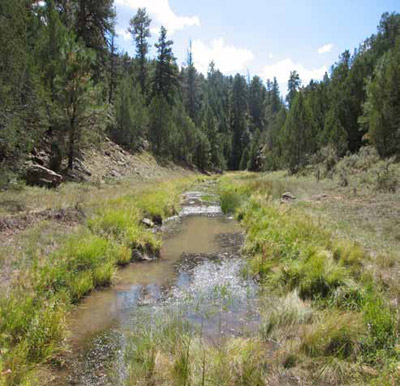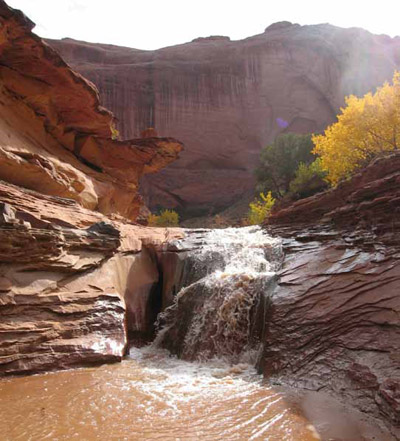Primary production plays a key role in determining aquatic community structure and function in stream ecosystems. Products of primary production found in aquatic ecosystems come from two sources: the growth of algae and plants in streams (autochthonous inputs); and organic matter originating from the surrounding riparian and upland vegetation (allochthonous inputs).

NPS
Aquatic macroinvertebrates play a key role in nutrient cycling in aquatic ecosystems because they are the primary processors of organic materials. Many streams, especially those in the Southwest, are controlled primarily by allochthonous inputs of energy (Cummins 1974, Fisher 1995). Some studies have suggested that aquatic macroinvertebrates are responsible for processing up to 73 percent of the riparian leaf litter that enters a stream (Covich et al. 1999). This nutrient rich food source, in turn, increases growth rates, biomass, and survival of aquatic macroinvertebrates. In southwestern streams, this secondary productivity is among the highest in the country, with rates 2-13 times greater than secondary productivity found in streams in the eastern United States (Fisher & Gray 1983).
Functional Feeding Groups
Aquatic macroinvertebrates serve multiple functions in freshwater ecosystems. In addition to their role as primary consumers processing live organic material, they also serve as detritivores, consuming decomposing organic matter; predators, consuming macroinvertebrates and other small organisms; and prey, serving as food for fish, amphibians, reptiles, aquatic birds, and mammals. Many species of aquatic macroinvertebrates have evolved highly specialized feeding structures and behaviors in order to adapt to different food sources and competition within the aquatic environment. As a result, aquatic ecologists have categorized the many species of aquatic macroinvertebrates into four functional feeding groups (Cummins 1973) which can be used to describe how aquatic ecosystems function: shredders, collectors, grazers (or scrapers), and predators.
- Shredders are responsible for processing coarse particulate organic matter (CPOM). CPOM is greater than 1 mm in size and typically derived from allochthonous sources, such as woody debris, leaves, and other vegetation from the neighboring riparian corridor. Examples of shredders in the Southwest include the caddisfly (Heteroplectron californicum) and the stonefly (Zapada cintipes).
- Collectors filter and collect smaller particles of organic matter (FPOM) found in the water column and bottom sediments. FPOM can range in size from 0.01-1.0 mm and usually arrives in water columns and benthic sediments as a result of CPOM being broken up by shredder species. Examples of collector species include the beetle (Zaitzevia parvula) and the Dipteran (true flies) (Antocha monticola).
- Grazers are found on rocks and woody debris, feeding on periphyton, detritus, and submerged aquatic plants. Most gastropods (snails) are grazer species; other grazers in the Southwest include the caddisfly (Helicopsyche borealis) and the beetle (Optioservus quadrimaculatus).
- Predators prey on animal tissue. The primary food sources for this group are other Glen Canyon National Recreation Area aquatic macroinvertebrates. Many southwestern dragonflies, such as the riffle darner (Opolonaeschna armata) and Pacific spiketail (Cordulegaster dorsalis), are voracious predatory species.
River Continuum Concept

NPS
According to the River Continuum Concept (RCC), the presence and abundance of functional groups at any point along a lotic ecosystem may be predicted by considering the physical process that formed the streambed and the amount of sunlight occurring at that point. The RCC, proposed by Vannote et al. (1980), predicts that aquatic macroinvertebrate communities will change in functional composition as one moves downstream, further away from the headwaters. Lower order streams are typically narrower and dominated by dense riparian vegetation, which shades the stream and restricts sunlight availability at the stream surface. Energy inputs in low order streams are the result of allochthonous sources, primarily in the form of litter from riparian vegetation. The RCC predicts that the aquatic macroinvertebrate community in such streams should reflect the food sources available in the stream. As a result, the community in lower order streams should be dominated by shredder and collector species. Shredder species will forage on large allochthonous inputs and turn them directly into biomass. Any remaining finer particles (FPOM) from the initial breakdown of CPOM, either through natural stream processes or shredder feeding, will be taken up by the collector species. Grazers and predators should also be present, but in lower abundances because they are less functionally important to the community.
According to the RCC, as stream order increases, aquatic macroinvertebrate communities should shift to reflect that change. In mid-order streams, channel width increases and riparian vegetation shades less of the stream, permitting more sunlight to reach the stream surface. Allochthonous energetic inputs into the system are reduced and autochthonous inputs in the form of periphyton become more important. As a result, the community shifts from being dominated by shredders and collectors to being dominated by grazers and collectors. The abundant periphyton is taken up by grazer species and transferred into biomass. Collectors are equally abundant as grazer species, so that any FPOM leakage from upstream communities as well as FPOM created from the increased periphyton is taken up by the assembled community members. In the largest rivers, FPOM is the dominant energy input in the system. Large rivers also experience a decrease in light penetration compared to mid-order streams. As a result, the RCC predicts that aquatic macroinvertebrate communities in large-order streams should be dominated by collector species due to the increased FPOM present and the loss of periphyton to the system.
The RCC has been the accepted paradigm of stream ecology since it was first proposed nearly 30 years ago. However, there is debate about how lotic systems in arid regions, such as the Southwest, fit into the model. Studies of southwestern streams with high autochthonous primary production show that the aquatic macroinvertebrate communities are dominated by collector species and not shredder species as the RCC would predict (Fisher et al. 1982; Jackson and Fisher 1986). It has been suggested that large flash flood events, prevalent in these systems, may be responsible for this aberration. After flash floods occur, large fluxes of allochthonous FPOM enter the system. Aquatic macroinvertebrate communities appear to be structuring themselves, particularly in summer months, to take advantage of these increased FPOM loads.
This community structuring appears to be an occurrence that is biologically unique to lotic systems in the Southwest.
Prepared by Stacy Stumpf, Patty Valentine-Darby, and Evan Gwilliam, NPS Inventory and Monitoring Program, 2009.
Part of a series of articles titled Aquatic Macroinvertebrates in the American Southwest.
Last updated: May 12, 2015
